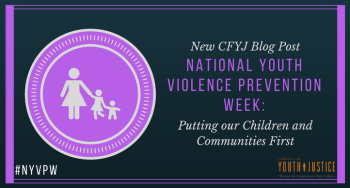National Youth Violence Prevention Week: Putting our Children and Communities First

By Harmeet Kamboj, Communications Associate
This week marks National Youth Violence Prevention Week, an initiative spearheaded by Students Against Violence Everywhere (SAVE) and Sandy Hook Promise to "raise awareness and to educate students, teachers, school administrators, counselors, school resource officers, parents, and the public on effective ways to prevent or reduce youth violence." In light of the recent Parkland, Florida school shooting and resulting policy talks addressing school safety, CFYJ hopes this year's Youth Violence Prevention Week sparks a conversation that not only forefronts the safety of our youth and communities, but also underscores the need for school- and community-based support services that benefit our children in the long term.
Just one week before the tragic shooting at Marjory Stoneman Douglas High School, Rep. John Rutherford (R-Florida) introduced the Students, Teachers, and Officers Preventing School Violence Act of 2018, otherwise known as the STOP School Violence Act. The bill, which has since passed the House in a 407-10 roll call vote, would reauthorize and earmark $50 million to the Department of Justice's Secure Our Schools program. The program would grant schools funding for enhanced security measures, such as metal detectors, surveillance cameras, personnel, and training.
The STOP School Violence Act plainly ignores a number of the underlying causes and side effects of youth violence – namely mental illness, financial hardship, and family instability. While Congress appears prepared to arm teachers, increase surveillance, and up the presence of school resource officers, no legislation has been proposed to fund services that encourage the long-term wellbeing of our youth. Grants for the training and employment of more school psychologists, therapists, and trained crisis managers will allow teachers and school administrators to steer students away from violent behaviors in a way that benefits students and communities alike.
Not only does increased security and surveillance offer a superficial solution to a complex problem, the heightened presence of security guards and resource officers in our schools will disproportionately impact low-income students of color and students with disabilities, as countless prominent studies have already shown. Justifying the arrest of troubled students for simple infractions at school perpetuates the already-burgeoning school-to-prison pipeline and does nothing to address the underlying issues facing these students and their families.
When youth of color are unfortunately funneled into our criminal justice system – often through the school-to-prison pipeline – they are nine times as likely as their white peers to be tried in adult court. When placed in adult detention facilities, youth must be separated from adults, and as a result, can be locked in solitary confinement for up to 23 hours a day. This extreme isolation can result in severe physical and mental illness that often goes untreated due to the lack of services and trained staff in these facilities. And once incarcerated youth return to their communities, those who served time in adult jails and prisons are more likely to recidivate. Keeping these youth in their communities and out of detention offers them a higher chance to rehabilitate and build a foundation for a safer, more secure future.
For more information, a schedule of events, and resources, visit the National Youth Violence Prevention Week website here.

